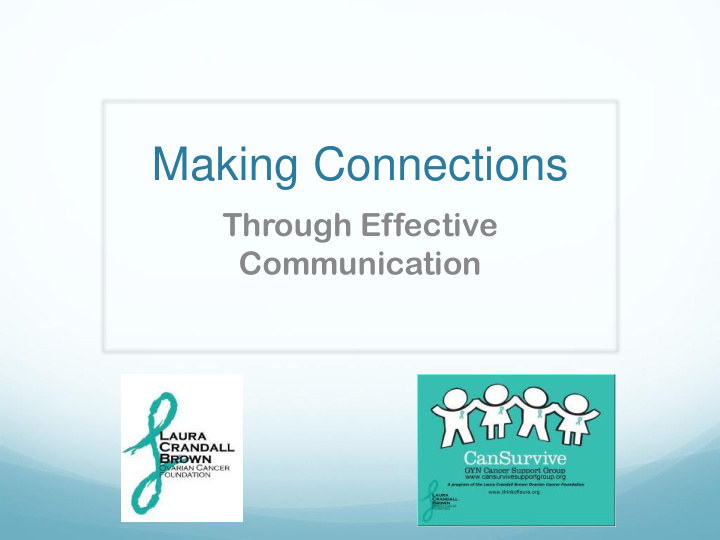



Making Connections Through Effective Communication
The Connection Evolution Email Telephone Texting/Messaging The Web Apps (Instagram, Twitter, etc.) Blogs Pinterest
The Evolution of Communication…
What’s Your Preferred Method of Connecting?
Two Ways to Stay Connected CaringBridge Free “journal” for those who want to keep subscribers informed about their journey Facebook Free social media outlet which can be open to the public, confined to just “friends” or even confined to a “members only” type group
More About CaringBridge Ginny Bourland My Background I had limited knowledge of it when diagnosed Very little exposure to cancer patients It took four emails to notify friends and family of my news due to the number of people we wanted to reach Too many emails to respond to My Experience Started an account in the hospital after hysterectomy CB has evolved and expanded Reaches more people than I would have imagined
What is CaringBridge The CB mission: To amplify the love, hope and compassion in the world, making each health journey easier. Started with the birth of a premature baby and a friend Began in 1997; became a non-profit in 2002 World-wide Relies on volunteers and donors
Why Use CaringBridge Simplification! Originally, appeal was enabling news to reach a mass audience Privacy controls allowed a range of options Supporters could offer encouragement – became a drug Writing became therapy Improvements over time: Attaching pictures Comments on each entry vs Guest Book Meal planners, visits, childcare, etc One-to-one correspondence, videos, even art
How to Use CaringBridge Get access to a computer/device and an email address A friend, spouse, child, etc can open it for you and author it, or you can manage yourself Sections: Overview – provide background/history Journal – where you write your story Comments – guest’s encouragement with each entry Guest Book – Guests can respond Photos – limited size but not number Planner – Meals, errands, housework calendars can be helpful Tributes – donations to the site in patient’s name Settings – “extras” to personalize
Overview
Journal
Guestbook
Photos
Planner
Tributes and Settings Tributes can be made in your loved one’s name – donations made for CB to continue Settings Theme can make your site your own Fundraising info Reports (emails of subscribers) Adding/removing pages
More About Facebook Doris Moody Personal Story Why I began What I’ve experienced since that time The good, the bad, the ugly and everything in between
What is Facebook? Facebook is a popular free social networking website that allows registered users to create profiles, upload photos and video, send messages and keep in touch with friends, family and colleagues. The site, which is available in 37 different languages, includes public features such as: Marketplace - allows members to post, read and respond to classified ads. Groups - allows members who have common interests to find each other and interact. Events - allows members to publicize an event, invite guests and track who plans to attend. Pages - allows members to create and promote a public page built around a specific topic. Presence technology - allows members to see which contacts are online and chat. http://whatis.techtarget.com/definition/Facebook
Why use Facebook? Keep up with family! (kids, grandkids, siblings, friends) Support each other (prayer requests, illness, deaths) Current news and events Entertaining Hobbies (via groups) Bargains Causes (such as CanSurvive or LCBF)
How to Use Facebook Must have e-mail address Visit www.facebook.com and begin. Basic set-up of your account Check privacy settings! Making “friends” Finding causes (such as CanSurvive ) to “Like”
When and What Do I Post? No set rule (see next slide…) Occasional photo or photos Favorite quote or philosophy Funny experience or joke Interesting recipes Share posts by others (seen in your News feed)
When and What NOT to Post
When and What NOT to Post Post month/DOB but not the year. No home address – phone numbers, etc.! Vacation plans Favorite song, pet’s name, mother’s maiden name, etc. Negativity about employer or co-employees Financial information (credit card debt, IRS audits) Racy photos Oversharing!
How Can We Help You?
Recommend
More recommend